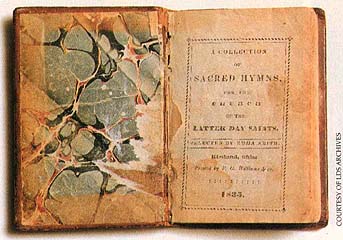
Joseph asked Emma to collect hymns to be used at worship services almost immediately after the organization of the church. Emma spent the next five years compiling what would become a collection of ninety hymns. She was careful in her selection and took time to pick and organize the best.
William W. Phelps helped her as he wrote some new poems to be used, adapted other text, making them doctrinally correct, and prepared the book for publication. Thirty-nine of the hymns were written by LDS poets.
The hymnbook was finally published in 1836, measuring approximately 3 x 4 inches. Only the text was published. Tunes were borrowed from other churches, as well as folk tunes, well known during the time period. These tunes could be selected at random by the person leading the congregation.
Today, our hymnbooks have the text and music together and we typically only sing one tune with each text. Back in the days of the early church, various tunes could be sung to the same text. Each tune had its own name and was easily identified.
In the back of our hymnbook, you will see a section on Meters. This is where you can play around with some of the tune options. For example, it could be interesting to sing Away in a Manger to the tune of More Holiness Give Me, or The Spirit of God to the tune of Now Let Us Rejoice, or visa versa. I have found by doing this, different words will be emphasized and a new meaning will emerge in the singing of these hymns.
Since Emma’s little hymnbook, there have been eight hymnbooks published with various selections included. Twenty-five of Emma’s original hymns are in our present-day hymnbook. The tunes have been modified over the years.
The hymnbook is mainly for the use of the congregation. The music is simple with typically four-part harmony. However, this form of composition is more complicated than in earlier days where everyone sang the same tune, with possibly a simple harmony added by musical people. Choir numbers have been added to past hymnbooks, where the music was much more elaborate than typical congregational singing.
Today, we have been asked to sing congregational and choir hymns straight from the hymnbook. These hymns can be beautifully sung, and simply rendered, as they are. But within the pages of the hymnbook, the variety is endless as we can mix various text with various tunes, change tempos, etc. Nowadays, many hymns are not sung because they are new, or forgotten. We sometimes rely on the more familiar hymns singing one or two verses and ignoring the additional verses added at the bottom of the page. There is much variety of beauty and gospel learning that is available in our hymnbooks, if we but study and experiment a little more with what we have.
How grateful we are to Emma’s organization, her love of music, and her research to get the best. And how we ought to thank those authors and composers who bring the Spirit to our tongues as we sing the songs of Zion.